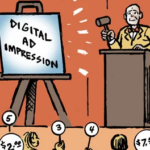“On TV & Video” is a column exploring opportunities and challenges in advanced TV and video.
Today’s column is by Jon Ahuna, SVP of operations at Viant.
Have you ever seen the same ad an ungodly number of times while watching your favorite programming? If so, you’re a victim of the current connected TV (CTV) experience.
This overexposure degrades user experience, wastes budgets and harms brands. Today, this is an imminently solvable problem. So, why haven’t we solved it?
There are several reasons, but let’s focus on two specific technical hurdles and how marketers can collectively overcome them through the smarter use of IDs.
Problem #1: Over-matching
As with “traditional” programmatic, CTV buyers and sellers must transact off of common identifiers. It’s a familiar dance. If a marketer wants to match an email list to CTV audiences, they typically try to link that email address to one of these identifiers.
But most households contain more than one person. Some individual household members even have multiple email addresses.
If an advertiser is targeting three users who live in the same home, the technology does not recognize them as a group with unified household shopping intent for kitchen cleaners or takeout pizza. Rather, advertisers treat them as three individuals who must each see the ads.
The result is severe overexposure.
Problem #2: No unified ID in the bidstream
In a related issue, CTV buyers have lacked a consistent ID to measure frequency across streaming apps. This requires buyers to rely on a mishmash of publisher- and platform-provided identifiers.
With no centralized frequency management, marketers are left to their own devices. Again, the result is overserved ads.
The root of the problem
Despite abundant research on co-viewing and TV sharing within households, the programmatic industry frequently resorts to yesterday’s tools to solve today’s challenges. (Consider our reliance on desktop ad formats in the mobile app environment. I don’t care how beautiful your 300×250 ad creative is, it’s going to look ugly on an iPhone.)
Fixing ad frequency requires aggregating IDs within a household and across publisher inventory. Many in the programmatic industry are working to build overarching IDs. They’re using email addresses, home addresses and other identifiers integrated with data from dozens of third parties (e.g., LiveRamp, Acxiom, Epsilon, TransUnion, etc.)
There’s another big obstacle, though. Many in the industry are still relying on email-based identity graphs. But Unified ID 2.0 alone, and the cross-publisher single sign-on system that underpins it, are unlikely to achieve the scale we need.
Even if single-sign is moderately scalable, it may not be enough to overcome the inconsistencies between personal and digital identifiers. CTV audiences will still be dramatically “over matched” at the household level.
A household ID is the only way.
The opportunity
To understand what’s at stake from the marketer’s point of view, let’s consider a national pharmacy chain that wants to drive incremental purchases beyond pharmaceuticals, like beauty supplies or back-to-school gear.
A campaign broadly targeted to “current customers” could easily rope in two or more members of a single household. Rather than see an ad for the desired frequency, say 2x, members of this family may end up seeing it with a frequency of 4x, 6x or more.
By resolving their individual personal IDs into a single household identity, the desired frequency is achieved and ROAS is maximized. The remaining budget can be reallocated toward expanding the campaign reach through competitive prospecting or look-alike targeting.
Many ad verticals stand to benefit from solving the frequency problem, from CPG to pet brands to automotive – essentially, any product that’s purchased on behalf of an entire household.
Getting frequency right
While progress has been made, several problems remain.
For example, individuals in a household don’t always watch TV together. As a result, getting to optimal frequency may actually overcorrect in the opposite direction. Frequency models that overcome this distortion are in the works, and they’re likely to vary by vertical.
The largest challenge, however, will be harnessing our industry’s collective willpower to act in the best interest of marketers and consumers.
For all our talk about personalization and so-called “better, more useful ads,” we haven’t done a great job of advocating for the end user experience. Fixing the frequency problem in TV is one area that will improve the television experience for viewers, while also leading to more efficient campaigns and stronger attribution.
And that’s something we can all get behind.
Follow Viant (@viant_tech) and AdExchanger (@adexchanger) on Twitter.













